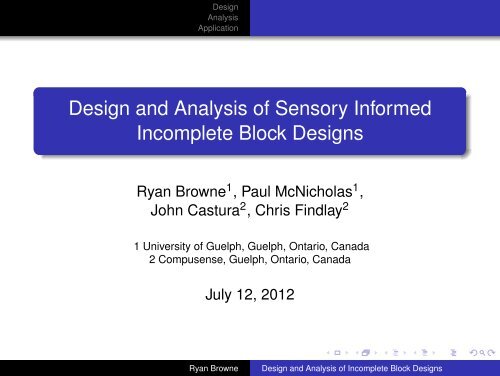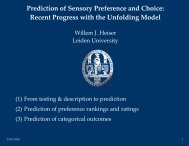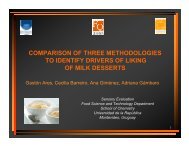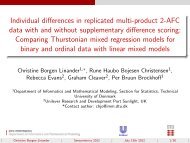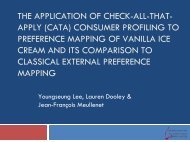Design and Analysis of Sensory Informed Incomplete Block Designs
Design and Analysis of Sensory Informed Incomplete Block Designs
Design and Analysis of Sensory Informed Incomplete Block Designs
You also want an ePaper? Increase the reach of your titles
YUMPU automatically turns print PDFs into web optimized ePapers that Google loves.
<strong>Design</strong><br />
<strong>Analysis</strong><br />
Application<br />
<strong>Design</strong> <strong>and</strong> <strong>Analysis</strong> <strong>of</strong> <strong>Sensory</strong> <strong>Informed</strong><br />
<strong>Incomplete</strong> <strong>Block</strong> <strong>Design</strong>s<br />
Ryan Browne 1 , Paul McNicholas 1 ,<br />
John Castura 2 , Chris Findlay 2<br />
1 University <strong>of</strong> Guelph, Guelph, Ontario, Canada<br />
2 Compusense, Guelph, Ontario, Canada<br />
July 12, 2012<br />
Ryan Browne<br />
<strong>Design</strong> <strong>and</strong> <strong>Analysis</strong> <strong>of</strong> <strong>Incomplete</strong> <strong>Block</strong> <strong>Design</strong>s
<strong>Design</strong><br />
<strong>Analysis</strong><br />
Application<br />
<strong>Incomplete</strong> <strong>Block</strong> <strong>Design</strong><br />
Observe a person’s response to 12 different products<br />
(r<strong>and</strong>omized block design)<br />
However for wine <strong>and</strong> other alcohol beverages products it<br />
is difficult to obtain an individual response to several<br />
products because <strong>of</strong> intoxication, carry-over, adaption <strong>and</strong><br />
fatigue.<br />
To compensate use balanced incomplete block designs.<br />
The goal is to determine if there is any clusters or grouping<br />
within the data.<br />
Ryan Browne<br />
<strong>Design</strong> <strong>and</strong> <strong>Analysis</strong> <strong>of</strong> <strong>Incomplete</strong> <strong>Block</strong> <strong>Design</strong>s
<strong>Design</strong><br />
<strong>Analysis</strong><br />
Application<br />
<strong>Sensory</strong>-<strong>Informed</strong> <strong>Design</strong>: Bread Study<br />
<strong>Sensory</strong> Pr<strong>of</strong>ile<br />
10-13 trained panelists<br />
Each panelists evaluates the 12 different Bread products<br />
on 42 attributes.<br />
Attributes for crumb<br />
Springiness<br />
Firmness<br />
Moistness<br />
Chewiness<br />
Particles<br />
Ryan Browne<br />
<strong>Design</strong> <strong>and</strong> <strong>Analysis</strong> <strong>of</strong> <strong>Incomplete</strong> <strong>Block</strong> <strong>Design</strong>s
<strong>Design</strong><br />
<strong>Analysis</strong><br />
Application<br />
Products in the <strong>Sensory</strong> Space<br />
-2 -1 0 1 2<br />
8<br />
6<br />
2<br />
7<br />
4<br />
5<br />
9<br />
1<br />
3<br />
-2 -1 0 1 2<br />
Ryan Browne<br />
<strong>Design</strong> <strong>and</strong> <strong>Analysis</strong> <strong>of</strong> <strong>Incomplete</strong> <strong>Block</strong> <strong>Design</strong>s
Mixture Modelling<br />
<strong>Design</strong><br />
<strong>Analysis</strong><br />
Application<br />
To find segments in the data, we assume the liking scores<br />
arise from a Gaussian mixture<br />
Y ∽<br />
G∑<br />
π g f (y|µ g , Σ g )<br />
g=1<br />
If we had a complete-block design we would just apply<br />
st<strong>and</strong>ard methodology to this problem.<br />
The literature commonly suggests imputation or some<br />
variation there<strong>of</strong>, for incomplete blocks.<br />
Ryan Browne<br />
<strong>Design</strong> <strong>and</strong> <strong>Analysis</strong> <strong>of</strong> <strong>Incomplete</strong> <strong>Block</strong> <strong>Design</strong>s
<strong>Design</strong><br />
<strong>Analysis</strong><br />
Application<br />
Imputation using the Average<br />
x1<br />
-5 0 5<br />
-5 0 5<br />
x2<br />
Ryan Browne<br />
<strong>Design</strong> <strong>and</strong> <strong>Analysis</strong> <strong>of</strong> <strong>Incomplete</strong> <strong>Block</strong> <strong>Design</strong>s
Missing Data<br />
<strong>Design</strong><br />
<strong>Analysis</strong><br />
Application<br />
However, it is possible to estimate a covariance matrix<br />
when some data are missing.<br />
We can do this via the expectation-maximization (EM)<br />
algorithm.<br />
This approach is particularly useful when the covariance<br />
matrix has a special structure.<br />
And even more so when<br />
Σ g = Σ<br />
Ryan Browne<br />
<strong>Design</strong> <strong>and</strong> <strong>Analysis</strong> <strong>of</strong> <strong>Incomplete</strong> <strong>Block</strong> <strong>Design</strong>s
<strong>Design</strong><br />
<strong>Analysis</strong><br />
Application<br />
Covariance Structures<br />
Mclust models - (Mclust in R)<br />
Σ g = λ g D g A g D T g<br />
Factor Analyzers - (pgmm package in R)<br />
Σ g = Λ g Λ T g + Ψ g<br />
Ryan Browne<br />
<strong>Design</strong> <strong>and</strong> <strong>Analysis</strong> <strong>of</strong> <strong>Incomplete</strong> <strong>Block</strong> <strong>Design</strong>s
<strong>Design</strong><br />
<strong>Analysis</strong><br />
Application<br />
Conditional Distribution <strong>of</strong> Missing Data<br />
To use EM algorithm we need to calculate the sufficient<br />
statistics for the missing data.<br />
X 1 |X 2 = x 2 ∽ MVN(µ 1 +Σ 12 Σ −1<br />
22 (x 2 − µ 2 ) , Σ 11 −Σ 12 Σ −1<br />
22 Σ 21)<br />
However, we have to calculate the expected sufficient<br />
statistics for the missing data in each row.<br />
This amounts to m choose k different matrix inverses.<br />
For the bread data 12 choose 6 =920 matrix inverses.<br />
Complete E-steps are not computationally feasible.<br />
Ryan Browne<br />
<strong>Design</strong> <strong>and</strong> <strong>Analysis</strong> <strong>of</strong> <strong>Incomplete</strong> <strong>Block</strong> <strong>Design</strong>s
<strong>Design</strong><br />
<strong>Analysis</strong><br />
Application<br />
Incremental E-step or E-Step by column<br />
If start with the missing data x i = (x i1 , x i2 , NA, NA) <strong>and</strong> fill<br />
in the missing data with r<strong>and</strong>omly generated observations.<br />
For for a particular row we say ˆx i = (x i1 , x i2 , ˆx i3 , ˆx i4 ). So,<br />
now we have a complete dataset.<br />
Go by column <strong>and</strong> update each estimated observation via<br />
e.g.<br />
ˆx i,j = µ j + Σ j,−j Σ −1<br />
−j,−j<br />
(ˆxi,−j − µ −j<br />
)<br />
ˆx 3 = µ 3 + Σ 3,−3 Σ −1<br />
−3,−3 (ˆx −3 − µ −3 )<br />
where ˆx −3 = (x i1 , x i2 , ˆx i4 )<br />
If we perform this iteratively then<br />
(ˆx 3 , ˆx 4 ) → µ (3,4) + Σ (3,4),(1,2) Σ −1<br />
(1,2),(1,2)<br />
(<br />
x(1,2) − µ (1,2)<br />
)<br />
Ryan Browne<br />
<strong>Design</strong> <strong>and</strong> <strong>Analysis</strong> <strong>of</strong> <strong>Incomplete</strong> <strong>Block</strong> <strong>Design</strong>s
EM by column<br />
<strong>Design</strong><br />
<strong>Analysis</strong><br />
Application<br />
If we have the inverse matrix <strong>of</strong> Σ<br />
[ ]<br />
σ1,1 Σ<br />
Σ =<br />
1,−1<br />
<strong>and</strong> Σ −1 = Θ =<br />
Σ −1,1 Σ −1,−1<br />
1<br />
θ 1,1<br />
Θ 1,−1 = Σ j,−j Σ −1<br />
−j,−j<br />
[ ]<br />
θ1,1 Θ 1,−1<br />
Θ −1,1 Θ −1,−1<br />
This result is possible due to a relationship between the<br />
Matrix Inverse <strong>and</strong> Schur Complement <strong>of</strong> a matrix<br />
We now have an incremental E-step for the 1 st moment.<br />
We can obtain a similar result for the 2 nd moment.<br />
Ryan Browne<br />
<strong>Design</strong> <strong>and</strong> <strong>Analysis</strong> <strong>of</strong> <strong>Incomplete</strong> <strong>Block</strong> <strong>Design</strong>s
EM<br />
<strong>Design</strong><br />
<strong>Analysis</strong><br />
Application<br />
From Neal <strong>and</strong> Hinton (1998) the EM can be viewed as<br />
minimizing<br />
F(N z , x i , θ) = logL(x i |θ) − D KL (N z ||N z.xi )<br />
E-step can be viewed as minimizing the Kullback-Leibler<br />
(KL) divergence between the missing data distribution <strong>and</strong><br />
the conditional distribution <strong>of</strong> the missing data given the<br />
observed data.<br />
Ryan Browne<br />
<strong>Design</strong> <strong>and</strong> <strong>Analysis</strong> <strong>of</strong> <strong>Incomplete</strong> <strong>Block</strong> <strong>Design</strong>s
Application<br />
<strong>Design</strong><br />
<strong>Analysis</strong><br />
Application<br />
Iris<br />
Bread<br />
Iris Dataset.<br />
Bread Dataset.<br />
Ryan Browne<br />
<strong>Design</strong> <strong>and</strong> <strong>Analysis</strong> <strong>of</strong> <strong>Incomplete</strong> <strong>Block</strong> <strong>Design</strong>s
Iris Dataset<br />
<strong>Design</strong><br />
<strong>Analysis</strong><br />
Application<br />
Iris<br />
Bread<br />
One <strong>of</strong> the most famous data sets in statistics.<br />
Four measurements on three types <strong>of</strong> flowers.<br />
We st<strong>and</strong>ardized the data <strong>and</strong> for each observation we<br />
r<strong>and</strong>omly removed two measurements.<br />
SepalLength Sepal.Width Petal.Length Petal.Width<br />
−1.34 −1.31<br />
−1.14 −1.34<br />
0.33 −1.31<br />
−1.50 0.01<br />
−1.34 −1.31<br />
−0.54 −1.05<br />
.<br />
.<br />
.<br />
.<br />
Ryan Browne<br />
<strong>Design</strong> <strong>and</strong> <strong>Analysis</strong> <strong>of</strong> <strong>Incomplete</strong> <strong>Block</strong> <strong>Design</strong>s
Original Iris Dataset<br />
<strong>Design</strong><br />
<strong>Analysis</strong><br />
Application<br />
Iris<br />
Bread<br />
-2 -1 0 1 2 3 -1.5 -0.5 0.5 1.5<br />
Sepal.Length<br />
-2 -1 0 1 2<br />
-2 0 1 2 3<br />
Sepal.Width<br />
Petal.Length<br />
-1.5 0.0 1.0<br />
-1.5 -0.5 0.5 1.5<br />
Petal.Width<br />
-2 -1 0 1 2<br />
-1.5 -0.5 0.5 1.5<br />
Ryan Browne<br />
<strong>Design</strong> <strong>and</strong> <strong>Analysis</strong> <strong>of</strong> <strong>Incomplete</strong> <strong>Block</strong> <strong>Design</strong>s
<strong>Incomplete</strong> Iris Data<br />
<strong>Design</strong><br />
<strong>Analysis</strong><br />
Application<br />
Iris<br />
Bread<br />
-2 -1 0 1 2 -1.5 -0.5 0.5 1.5<br />
Sepal.Length<br />
-1 0 1 2<br />
-2 0 1 2<br />
Sepal.Width<br />
Petal.Length<br />
-1.5 -0.5 0.5 1.5<br />
-1.5 -0.5 0.5 1.5<br />
Petal.Width<br />
-1 0 1 2<br />
-1.5 -0.5 0.5 1.5<br />
Ryan Browne<br />
<strong>Design</strong> <strong>and</strong> <strong>Analysis</strong> <strong>of</strong> <strong>Incomplete</strong> <strong>Block</strong> <strong>Design</strong>s
<strong>Design</strong><br />
<strong>Analysis</strong><br />
Application<br />
Iris<br />
Bread<br />
<strong>Incomplete</strong> Iris Data with Imputed Values<br />
-2 -1 0 1 2 -1.5 -0.5 0.5 1.5<br />
Sepal.Length<br />
-1 0 1 2<br />
-2 -1 0 1 2<br />
Sepal.Width<br />
Petal.Length<br />
-1.5 0.0 1.0<br />
-1.5 0.0 1.0<br />
Petal.Width<br />
-1 0 1 2<br />
-1.5 -0.5 0.5 1.5<br />
Ryan Browne<br />
<strong>Design</strong> <strong>and</strong> <strong>Analysis</strong> <strong>of</strong> <strong>Incomplete</strong> <strong>Block</strong> <strong>Design</strong>s
<strong>Design</strong><br />
<strong>Analysis</strong><br />
Application<br />
Iris<br />
Bread<br />
Comparison - Imputed <strong>Incomplete</strong> <strong>and</strong> Original Data<br />
<strong>Incomplete</strong> Data<br />
Original Data<br />
<strong>Incomplete</strong> Data<br />
Original Data<br />
Sepal.Width<br />
-2 0 1 2<br />
Sepal.Width<br />
-2 0 2<br />
Petal.Length<br />
-1.5 0.0 1.5<br />
Petal.Length<br />
-1.5 0.0 1.5<br />
-1 0 1 2<br />
-2 -1 0 1 2<br />
-1 0 1 2<br />
-2 -1 0 1 2<br />
Sepal.Length<br />
Sepal.Length<br />
Sepal.Length<br />
Sepal.Length<br />
<strong>Incomplete</strong> Data<br />
Original Data<br />
<strong>Incomplete</strong> Data<br />
Original Data<br />
Petal.Width<br />
-1.5 0.0 1.5<br />
Petal.Width<br />
-1.5 0.0 1.5<br />
Petal.Length<br />
-1.5 0.0 1.5<br />
Petal.Length<br />
-1.5 0.0 1.5<br />
-1 0 1 2<br />
-2 -1 0 1 2<br />
-2 -1 0 1 2<br />
-2 -1 0 1 2 3<br />
Sepal.Length<br />
Sepal.Length<br />
Sepal.Width<br />
Sepal.Width<br />
<strong>Incomplete</strong> Data<br />
Original Data<br />
<strong>Incomplete</strong> Data<br />
Original Data<br />
Petal.Width<br />
-1.5 0.0 1.5<br />
Petal.Width<br />
-1.5 0.0 1.5<br />
Petal.Width<br />
-1.5 0.0 1.5<br />
Petal.Width<br />
-1.5 0.0 1.5<br />
-2 -1 0 1 2<br />
-2 -1 0 1 2 3<br />
-1.5 -0.5 0.0 0.5 1.0 1.5<br />
-1.5 -0.5 0.0 0.5 1.0 1.5<br />
Sepal.Width<br />
Sepal.Width<br />
Petal.Length<br />
Petal.Length<br />
Ryan Browne<br />
<strong>Design</strong> <strong>and</strong> <strong>Analysis</strong> <strong>of</strong> <strong>Incomplete</strong> <strong>Block</strong> <strong>Design</strong>s
<strong>Design</strong><br />
<strong>Analysis</strong><br />
Application<br />
Iris<br />
Bread<br />
Comparison <strong>of</strong> the Latent Space - Iris Data<br />
Complete Data<br />
<strong>Incomplete</strong> Data<br />
factor 2<br />
-4 -2 0 2 4<br />
factor 2<br />
-4 -2 0 2 4<br />
-10 -5 0 5 10 15 20<br />
factor 1<br />
-10 -5 0 5 10 15 20<br />
factor 1<br />
Ryan Browne<br />
<strong>Design</strong> <strong>and</strong> <strong>Analysis</strong> <strong>of</strong> <strong>Incomplete</strong> <strong>Block</strong> <strong>Design</strong>s
<strong>Design</strong><br />
<strong>Analysis</strong><br />
Application<br />
Clustering Comparision<br />
Iris<br />
Bread<br />
Comparison <strong>of</strong> clustering results from using the incomplete iris<br />
data <strong>and</strong> the iris data.<br />
1 2 3<br />
1 50 0 0<br />
2 0 47 0<br />
3 0 3 50<br />
Ryan Browne<br />
<strong>Design</strong> <strong>and</strong> <strong>Analysis</strong> <strong>of</strong> <strong>Incomplete</strong> <strong>Block</strong> <strong>Design</strong>s
Data<br />
<strong>Design</strong><br />
<strong>Analysis</strong><br />
Application<br />
Iris<br />
Bread<br />
420 consumers.<br />
12 white breads.<br />
Each individual evaluated 6 breads within a sensory<br />
informed incomplete block design.<br />
Present-3 <strong>and</strong> present-4 designs were nested within the<br />
present-6 design.<br />
Six groups <strong>and</strong> two factors were chosen using the<br />
Bayesian Information Criterion (BIC).<br />
Ryan Browne<br />
<strong>Design</strong> <strong>and</strong> <strong>Analysis</strong> <strong>of</strong> <strong>Incomplete</strong> <strong>Block</strong> <strong>Design</strong>s
<strong>Design</strong><br />
<strong>Analysis</strong><br />
Application<br />
Iris<br />
Bread<br />
Latent Space - Bread Liking Scores<br />
12 present 3<br />
12 present 4<br />
12 present 6<br />
factor 2<br />
2 4 6 8 10 12<br />
factor 2<br />
2 4 6 8 10 12<br />
factor 2<br />
0 2 4 6 8 10<br />
-16 -14 -12 -10 -8 -6<br />
factor 1<br />
-16 -14 -12 -10 -8 -6<br />
factor 1<br />
-14 -12 -10 -8 -6 -4<br />
factor 1<br />
Ryan Browne<br />
<strong>Design</strong> <strong>and</strong> <strong>Analysis</strong> <strong>of</strong> <strong>Incomplete</strong> <strong>Block</strong> <strong>Design</strong>s
Conclusions<br />
<strong>Design</strong><br />
<strong>Analysis</strong><br />
Application<br />
Iris<br />
Bread<br />
We can find MLEs using incremental EM.<br />
We can obtain a reasonable estimate <strong>of</strong> the latent space<br />
using only incomplete data.<br />
This methodology can be used for imputation.<br />
Ryan Browne<br />
<strong>Design</strong> <strong>and</strong> <strong>Analysis</strong> <strong>of</strong> <strong>Incomplete</strong> <strong>Block</strong> <strong>Design</strong>s
The end<br />
<strong>Design</strong><br />
<strong>Analysis</strong><br />
Application<br />
Iris<br />
Bread<br />
Thank you.<br />
Ryan Browne<br />
<strong>Design</strong> <strong>and</strong> <strong>Analysis</strong> <strong>of</strong> <strong>Incomplete</strong> <strong>Block</strong> <strong>Design</strong>s


